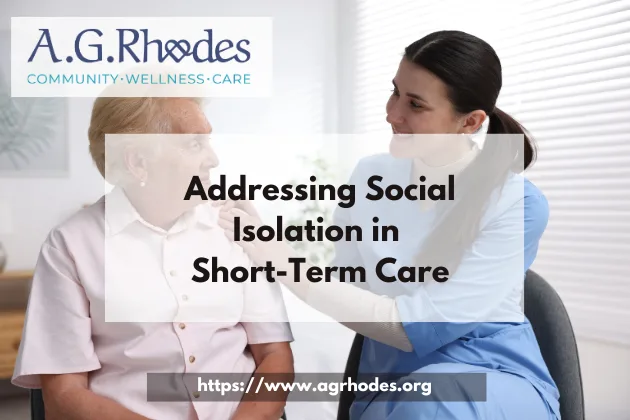
Understanding Social Isolation in Short-Term Care
Social isolation occurs when individuals have limited social interaction, emotional support, or meaningful relationships. In short-term care, this can stem from physical limitations, unfamiliar environments, or the temporary nature of the stay, which often makes it harder for residents to form lasting bonds.
Elderly patients and those recovering from illness or surgery are particularly vulnerable. The lack of consistent interaction can lead to feelings of loneliness, depression, and anxiety, all of which can slow the recovery process and diminish overall health outcomes.
Common factors contributing to social isolation include:
- Mobility challenges make participation in group activities difficult.
- Communication barriers, such as hearing loss or cognitive decline.
- Short-term stays reduce opportunities for forming relationships.
- Family and visitor limitations, particularly after hospitalization or due to distance.
Recognizing these challenges is the first step toward creating a more socially connected care environment.
The Emotional and Physical Impact of Isolation
Social isolation does not merely affect mental health—it can have significant physical repercussions. Research shows that loneliness can increase the risk of high blood pressure, heart disease, and weakened immune response.
Emotionally, residents may experience heightened feelings of sadness, fear, and hopelessness, which can interfere with their motivation to engage in therapy and rehabilitation. In short-term care settings where recovery and active participation are vital, this emotional withdrawal can directly slow progress.
Moreover, prolonged isolation can increase the risk of cognitive decline in elderly residents, as social interaction is closely tied to brain health and function. Therefore, addressing social isolation is not only an act of compassion—it’s a cornerstone of effective patient care.
Creating Socially Supportive Care Environments
A socially connected environment fosters faster recovery, better emotional stability, and higher satisfaction rates among residents. Care facilities can combat isolation by integrating programs and practices that encourage interaction and inclusion.
1. Structured Group Activities
Group exercises, art sessions, music therapy, and recreational games allow residents to engage socially while participating in activities that promote mental and physical health. These programs build community and help individuals feel they are part of something meaningful.
2. Personalized Engagement Plans
Each resident’s social and emotional needs are unique. By developing individualized care plans that include social goals—such as regular visits, phone calls, or participation in interest-based clubs—caregivers can ensure each person receives appropriate support.
3. Volunteer and Intergenerational Programs
Inviting community volunteers or organizing visits from schools and local organizations can foster joy and connection. Intergenerational interactions, in particular, have been shown to lift spirits, enhance empathy, and strengthen community bonds.
4. Technology-Facilitated Connections
When in-person visits are limited, video calls, virtual support groups, and digital activity sessions can help residents stay in touch with loved ones and remain socially engaged. Training residents on basic device use empowers them to maintain relationships beyond facility walls.
5. Supportive Dining Experiences
Shared meals are powerful opportunities for conversation and companionship. Designing communal dining spaces that encourage interaction can greatly reduce loneliness while promoting better nutrition and overall well-being.
Empowering Staff to Recognize and Reduce Isolation
Staff members play a pivotal role in identifying residents at risk of social isolation. Training caregivers to recognize early signs—such as withdrawal, reduced communication, or sadness—enables proactive intervention.
Encouraging compassionate communication, active listening, and meaningful daily interactions between staff and residents creates a culture of warmth and belonging. Facilities can also provide emotional support training to enhance caregiver empathy and understanding.
Additionally, consistent staff assignments, where residents see familiar caregivers regularly, help establish trust and continuity—factors that significantly reduce feelings of isolation.
Involving Families in the Care Journey
Family connections are essential in mitigating isolation. Facilities should encourage families to participate in care planning, attend social events, and maintain regular contact with their loved ones.
Providing families with education about the emotional challenges residents may face can help them offer better support. Furthermore, flexible visitation policies and family-inclusive programs foster a sense of partnership in the care process.
Even when distance prevents frequent visits, consistent communication through letters, calls, or recorded video messages can help residents feel remembered and loved.
Promoting Emotional Resilience Among Residents
While external support is critical, building emotional resilience empowers residents to manage feelings of loneliness and maintain a positive outlook. Activities like meditation, journaling, and mindfulness sessions can promote self-reflection and inner calm.
Facilities can also provide mental health counseling and peer support groups, giving residents a safe space to share experiences and emotions. Encouraging residents to celebrate small milestones in their recovery can boost self-esteem and help them maintain motivation throughout their stay.
Designing Spaces that Encourage Connection
The physical environment of a care facility greatly influences social behavior. Thoughtful design—such as welcoming common areas, outdoor gardens, and cozy lounges—can promote spontaneous interaction and relaxation.
Natural lighting, pleasant colors, and accessible seating arrangements all contribute to a sense of comfort and community. When residents feel safe and relaxed in shared spaces, they are more likely to engage with others and form meaningful relationships.
Building a Community of Compassion and Connection
Addressing social isolation in short-term care requires more than clinical treatment—it demands a holistic approach centered on human connection, empathy, and engagement. When care facilities prioritize social well-being, residents not only recover faster but also regain confidence, joy, and a sense of belonging.
At A.G. Rhodes, we are dedicated to creating a caring environment where residents feel valued, supported, and connected every day. Through innovative programs, compassionate staff, and strong family partnerships, we strive to ensure that every individual experiences not just excellent care, but genuine community.
Contact A.G. Rhodes today to learn more about our short-term care programs and how we help residents thrive both physically and emotionally.

